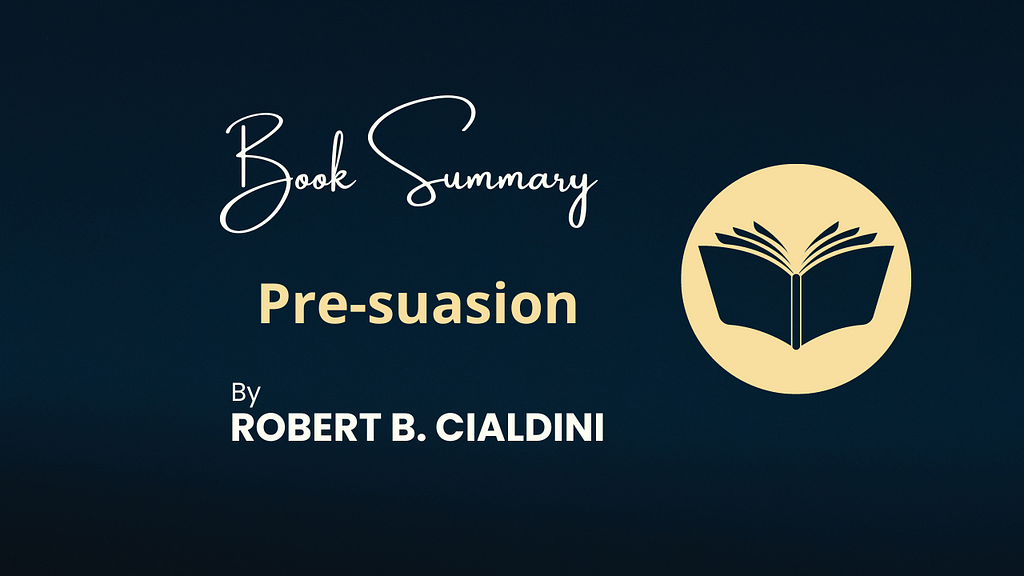
“Pre-Suasion: A Revolutionary Way to Influence and Persuade” by Robert B. Cialdini delves into the often overlooked moments before the actual persuasion attempt, uncovering powerful techniques that shape the success of influence. In this summary, we’ll explore 10 key ideas from the book, each accompanied by examples illustrating the pre-suasive strategies outlined by Cialdini.
The Primacy of Attention: Setting the Stage for Persuasion
Cialdini emphasizes the crucial role of capturing attention before attempting to persuade. He illustrates with the example of a waiter who highlights the specials before presenting the menu, directing attention to specific choices.
The Importance of Establishing Positive Associations
The book explores the impact of creating positive associations in the moments leading up to persuasion. For instance, an advertiser may strategically place images of family and happiness before introducing a product to evoke positive emotions.
The Power of Unity: Creating Inclusivity for Influence
Cialdini introduces the concept of unity, emphasizing the influence of shared identities. An example is a salesperson using inclusive language, fostering a sense of unity with the customer, which can enhance the likelihood of a successful persuasion attempt.
The Significance of Timing in Persuasion
Timing is a critical element in pre-suasion. Cialdini discusses how presenting a message at a time when individuals are naturally more receptive can significantly impact persuasion. For instance, discussing a product’s benefits during a positive moment can enhance its appeal.
Creating Anticipation for Persuasion Success
Anticipation plays a key role in preparing individuals for persuasion. Cialdini suggests that creating a sense of anticipation can make people more receptive to the subsequent message. An example is a speaker teasing an exciting announcement to engage the audience’s anticipation.
The Influence of Frame of Mind: Shaping Perspectives in Advance
Cialdini explores how shaping someone’s frame of mind before a persuasive attempt can impact the outcome. For instance, a manager praising a team’s past achievements before proposing a new project can influence their mindset and receptiveness.
Leveraging the Power of Labels: Defining Perspectives Before Persuasion
The book discusses the use of labels to define perspectives in advance. An example is a politician strategically labeling a policy as “pro-family” to shape public perception before presenting the details.
Evoking Curiosity to Enhance Persuasion
Cialdini highlights the persuasive potential of evoking curiosity before delivering a message. For example, a marketer may use a mysterious teaser campaign to pique interest before revealing a new product.
The Influence of Language in Pre-Suasion
Language plays a critical role in setting the stage for persuasion. Cialdini discusses how specific words and phrases can prime individuals for the intended message. An example is a charity campaign using language that emphasizes shared responsibility and community support before making a donation request.
Anchoring Beliefs for Future Persuasion
Cialdini concludes by discussing the concept of anchoring beliefs, emphasizing how pre-suasive efforts can anchor certain beliefs that make subsequent persuasion attempts more effective. For instance, a financial advisor may first emphasize long-term stability to anchor the belief in a secure investment strategy.
“Pre-Suasion” provides a groundbreaking perspective on the art of influence, focusing on the moments leading up to persuasion. Cialdini’s insights, from attention primacy to the power of language, offer a strategic guide for anyone seeking to enhance their persuasive abilities. By understanding and applying these pre-suasive principles, individuals can elevate their influence and achieve more effective outcomes in various scenarios.
Book Summary “Pre-Suasion” by Robert B. Cialdini was originally published in SnippetSnackBooks on Medium, where people are continuing the conversation by highlighting and responding to this story.